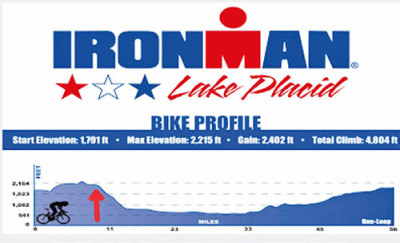
12:43 p.m. (5 hours since race start)
At the end of the first loop is a choice, go left or go right.
(Morphius’s red or blue pill?)

Left was for bike dismount and the start of your run.
Right was for the second loop.
(Do we really need to do a second loop?)
Yes.
(No one would know.)
I have a timing chip on my ankle. People are following me live. Everyone would know.
Once again, I let the experience calm me down at the mile 2 marker when my pace grounded to what felt like a standstill. I was now at mile 58 of 112 on the bike course.
It was experience that helped me guide the bike down Keene.
(Keene is a place?)
Keene is a town near Lake Placid. On the bike course, Keene is 10 miles away from the race start. But when you mention Keene to a triathlete, all they think of is, a mile and a half of steep downhill.
(How steep?)
Last year when I reached the bottom of Keene I was going 42 miles per hour.
(So?)
So, I didn’t need to pedal for the next three miles because I was going so fast.
(Ok, wait. Stop the narrative. What does 42 mph feel like when you are riding on 25 millimeters of rubber?)
It is exciting and terrifying.
It requires all of my mental and physical energy. Every decision had to be perfect, or my race would be over.
(What do you mean by over?)
A crash while riding my bike at a walking pace means a section of my body would absorb force upon contact with the ground. In 16 years of triathlon, I have crashed five times; four of them at a pedestrian pace.Twice, I scraped my shins to the point where they were red. Once, I dislocated my thumb, which I popped back into place on the spot. In 2012 a car tried to cut me off. As it passed me, I was knocked to the ground, breaking my arm.
(And the one time you were not moving at a pedestrian pace?)
In 2018 I was going 20 miles per hour down a hill. There should have been a sign warning me of a sharp turn at the bottom. According to a friend behind me, when I turned at the bottom, “the wheels lost contact with the ground.”
I don’t remember hitting the ground or my body skidding down the road for several feet. It all happened so fast. When I came to a stop, I was still clipped into the bike.
My first thought was, “I don’t think anything is broken.” So, I wiggled my fingers and toes to be sure.
My second thought was, “Is the bike broken?” My shoes were still clipped into the bike.
I first had to unclip myself, something I had never done before while lying on my side.
The bike was damaged, but I bent the derailleur back into place. I was bleeding, but I climbed back on … and I rode on. I finished that 2018 ride, but it took weeks to recover. All of these memories were running through my head as I started the descent into Keene.
A crash, now at highway driving speeds, would have ended my race. There would be no bending things back into place for me or the bike. Hitting the ground at speeds over 40 mph would result in a broken clavicle or pelvis … or worse.
I know this because it happened to another rider here on this decent back in 2017. I didn’t see it, but I read about it … a lot. He didn’t see an orange traffic cone in the center of the road.
Greater still is the risk that if one treats this with hubris and disdain, one can go flying off the mountain.
(So, why do it? Why not ride down at 20 mph, while pumping your brakes?)
President Kennedy said in 1962, “We choose to go to the moon, not because it is easy, but because it is hard.” It is more than the exhilaration of the wind in your ears at the speeds that cars travel, it is the challenge to go faster than before. Racing is about challenging yourself to do the “hard” thing and find that you have within you the ability to do things you didn’t think you could—in my case, things you were scared of. On this second loop, I shelved my fear, focused my eyes on the road in front of me and I pedaled as fast as I could to start my descent on Keene.
1:27 p.m. (5.75 hours since race start)
David Roher is a USAT certified triathlon and marathon coach. He is a multi-Ironman finisher and veteran special education teacher. He is on Instagram @David Roher140.6.
He can be reached at [email protected].










